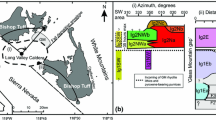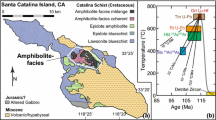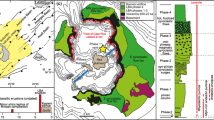Abstract
The diffusive relaxation of trace element profiles in plagioclase phenocrysts may provide important constraints on magma residence times in crustal magma chambers. Initial trace element profiles in plagioclase phenocrysts are governed by variations in the concentration of a trace element in the melt and by the plagioclase-melt partition coefficient. Trace element diffusion will subsequently act to modify this initial profile and – given enough time – produce a profile that is in equilibrium with the anorthite variations within the crystal. We argue that the trace element partition coefficient Da/b between two parts a and b of a plagioclase crystal of variable anorthite content is equal to the ratio of their crystal-liquid partition coefficients, and that the equilibrium profile of the crystal can be calculated. The time required to establish diffusive equilibrium is dependent on the wavelength and amplitude of the initial trace element concentration range and on the diffusivity of the trace element in plagioclase. Strontium plagioclase-melt partition coefficients and diffusivities are calculated for a range of magmatic temperatures and plagioclase compositions. A one-dimensional diffusion model is developed that describes the diffusive destruction of oscillatory trace element zoning with time and allows the calculation of upper limits for plagioclase crystal residence times in a magma reservoir. The model is tested using major and trace element concentrations measured along crystal traverses of plagioclase phenocrysts from the Kameni Island dacites, Santorini, and from the 1979 Soufriere andesite, St. Vincent. Three out of eight plagioclase phenocrysts have Sr concentration profiles that are not in diffusive equilibrium. For these, the diffusion model is employed to calculate maximum crystal residence times from incomplete diffusive equilibration of trace element zoning in plagioclase. Maximum crystal residence times range from 100 to 450 years. This is in good agreement with estimates from crystal size distribution and from Ra-Th disequilibrium studies for the Kameni Islands. For Soufriere, however, such short residence times are incompatible with U-Th mineral errorchron data that suggest residence times of >40 ka in a thermally buffered magma reservoir. To reconcile these apparently different ages, we invoke a more complicated magmatic history for Soufriere where an initially buffered magma reservoir is disturbed by magma mixing and suffers limited additional crystal fractionation prior to eruption.
Similar content being viewed by others
Author information
Authors and Affiliations
Additional information
Received: 20 October 1998 / Accepted: 22 March 1999
Rights and permissions
About this article
Cite this article
Zellmer, G., Blake, S., Vance, D. et al. Plagioclase residence times at two island arc volcanoes (Kameni Islands, Santorini, and Soufriere, St. Vincent) determined by Sr diffusion systematics. Contrib Mineral Petrol 136, 345–357 (1999). https://doi.org/10.1007/s004100050543
Issue Date:
DOI: https://doi.org/10.1007/s004100050543




